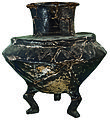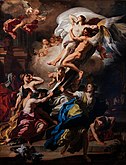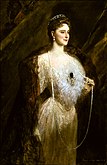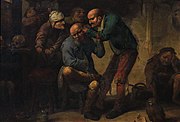National Art Museum of Azerbaijan
Azərbaycan Milli İncəsənət Muzeyi | |
 Palace of De Boure - first building of the Azerbaijan National Museum of Art | |
 | |
| Established | 1936 |
|---|---|
| Location | Niyazi Street 9/11, Baku, Azerbaijan |
| Type | Art museum |
| Collection size | 15,000 items: 3,000 items displayed (12,000 items stored) |
| Public transit access | M 1 Icheri Sheher metro station |
| Website | Nationalmuseum.az |
Azerbaijan National Museum of Art (
History
In 1936, the
In July 1993, various artworks had been stolen from the museum and were later retrieved.[3]
In 2006, the building was thoroughly reconstructed and the opening of a new exhibition took place in 2009. In 2011, the museum was declared to be of first National and then European Museum Standard (EUMS), meeting international standards and criteria, as appropriate for a museum and implying high-quality museum services and professional experience; this was by unanimous decision of the Council of Directors of the European Economic Chamber of Trade, Commerce and Industry – EEIG - located in Brussels. In May 2022, on International Museum Day, the Museum held a multimedia Museum Night as part of a strategic partnership with the UN to promote sustainable development.[4][5]
There are approximately 9,000 scientific books and monographs, catalogues, albums and other professional literature in the library of the museum. There is also a rare book collection of old publications.
Exhibits preserved in the collection of Azerbaijan National Museum of Art include antique works of art that date from the 4th century BC. Ceramic bowls decorated with archaic ornamentation found in
Along with the carpets, other types of Azerbaijan decorative and applied arts, such as different techniques of embroidery, artistic metalwork, artistic fabrics, carving in wood, jewellery making, etc. are exhibited here. The gold thread embroidery of "gulabatin" type is widely spread throughout Azerbaijan. Shamakhi, Shusha, and Baku have traditionally been centers for this kind of art. Red and green velvet used to be the base for the gold and silver thread embroidery. Hats and so-called "arakhchins" were ornamented with rosettes and medallions made from stylized petals and stars. The "arkhalig" and "kulaja" also used to be embroidered with gold threads. The objects of different shape, size and purpose embroidered with gold threads including "arakhchins", kerchiefs, shoes, étuis for combs and cosmetics, dyes for eyebrows and eyelashes, étuis for watches, pencil-boxes, and many other things are displayed at the museum.
Collection
Seven of the rooms in the first building feature
The second edifice built in 1885 houses
Among Azerbaijani artists represented are painters
fill one entire room.The museum also holds
The first works were obtained from
Architecture
Calm horizontal division of the building is harmonized with verticals of clubhouse and Sadikhov's residential building. Von derr Nonne in regards to red lines of free streets was not connected to other buildings. The volumetric solution was implemented to the building to highlight its location and its view to the sea[7] Classical elements, plastic means on rustication's background highlight the architectural style of the building.
This kind of buildings was usually made in the central streets of big cities. The gallery was also unique in the way it looked and was noticeable among other buildings. This building is considered one of the first attempts in the implementation of porticoes on the main facade, loggias - on the side and other plastic means. All this differentiates the building among others and gives volume on the perimeter of the building.[8]
The collection of antique and medieval art of Azerbaijan
This collection includes works of art from antique and Middle Ages, including figures of birds from Manna, female figures from III-I centuries BC, various ancient dishes from various territories of Azerbaijan which were found during excavations, a tombstone in a shape of horse, etc.
Gallery
-
Theotokos of Vladimir, late 16th century
-
Our Lady of Kazan, late 17th century
-
Bernardino Luini - St. Catherine, 16th century
-
Andrea del Sarto - Madonna of the Harpies, 1517-1519
-
Bartolomeo Schedoni - John the Baptist, 17th century
-
Francesco Solimena - Boreas Abducting Oreithyia, Daughter of Erechteus, 1729
-
Guercino - Sleeping Endymion, 17th century
-
Leandro Bassano - Portrait of an Old Woman
-
Balthasar Beschey - Venera and Adonis
-
Pieter Claesz - Still life
-
Justus Sustermans - Portrait of F. Medici, 17th century
-
Michiel Jansz. van Mierevelt - Portrait of the Duke of Wallenstein, 17th century
-
Frans Hals - Portrait of a man
-
Jean-Joseph Benjamin-Constant - Portrait of the Empress Alexandra Fyodrovna, 19th century
-
Friedrich August von Kaulbach - Portrait of Grand Duchess Elisabeth Feodorovna, 19th century
-
Jean-Baptiste Greuze - Portrait of a young woman, 18th century
-
Eduard Joseph d'Alton - Portrait of a woman, 19th century
-
Louis XV of France
-
Charles Le Brun - Banishment of Iliadore
-
Adriaen Brouwer - Scene at a surgeon, 17th century
-
Johann Heinrich Roos - Herd, 1676
-
Louis Victor Watelin - Landscape, 1873
-
Gaspard Dughet - Landscape
-
Ivan Aivazovsky - The road in the woods, 1857
-
Ivan Shishkin - The road in the woods
-
Jean-Honoré Fragonard - Pastorale
-
Vasili Pukirev - Interrupted wedding
-
Ogtay Sadıgzadeh - Portrait of Khurshidbanu Natavan
See also
References
- ^ a b c Azerbaijan Soviet Encyclopedia. State Publishing House of the Council of Ministers of Azerbaijan SSR. 1976. pp. 1st vol, p. 144.
- ^ "Breathing Life Back Into Art: The National Art Museum". Azer.com. Retrieved 2008-04-06.
- New York Times. Retrieved 5 November 2020.
- ^ Azernews.Az (2022-05-17). "Museum Night once again back in Baku". Azernews.Az. Retrieved 2022-05-23.
- ^ "Museum Night returns with multitude art projects [PHOTO/VIDEO]". Azernews.Az. 2022-05-19. Retrieved 2022-05-23.
- ^ "The Azerbaijan National Art Museum". nationalmuseum.az. Archived from the original on 2017-10-17. Retrieved 2017-05-18.
- ^ Erifzade. Narimanov Avenue - the principles of architectural and planning solutions. p. 111.
- ^ "gradostroitelstvo_baku_xix_nachala_xx_vekov". www.azeribooks.narod.ru. Retrieved 2019-10-28.
External links
- Official website Archived 2018-03-22 at the Wayback Machine (in English)
- Museum's overview (Bakupages.com)

































